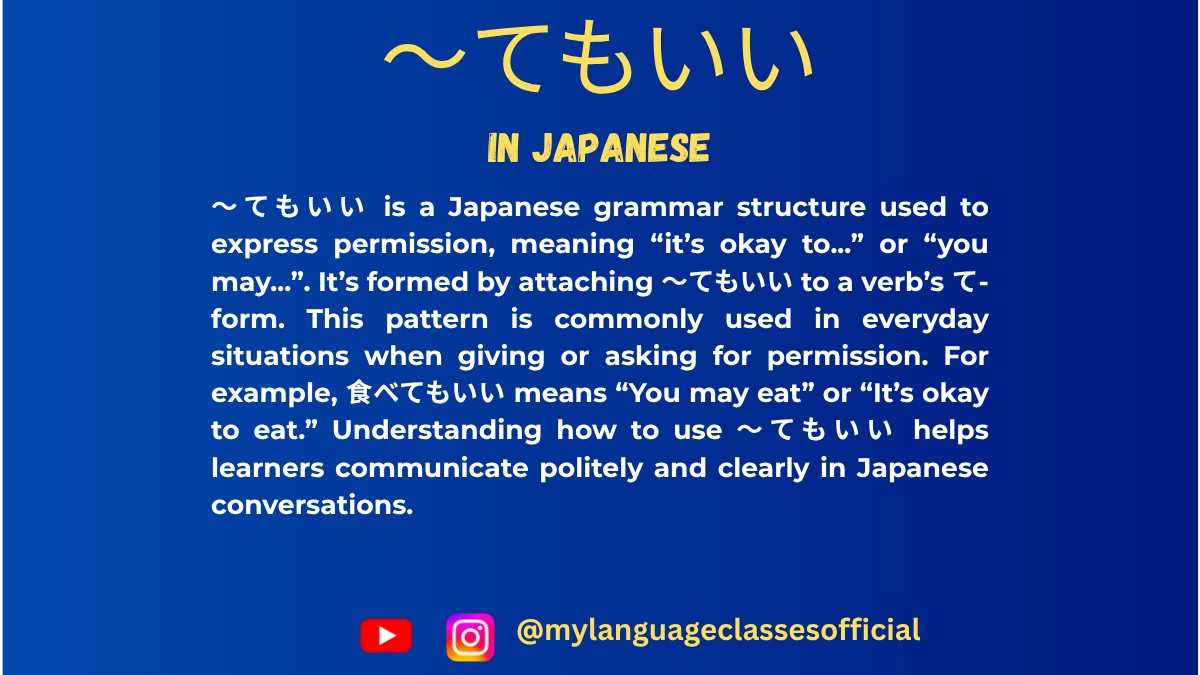Your cart is currently empty!
Tag: Japanese language learning
-
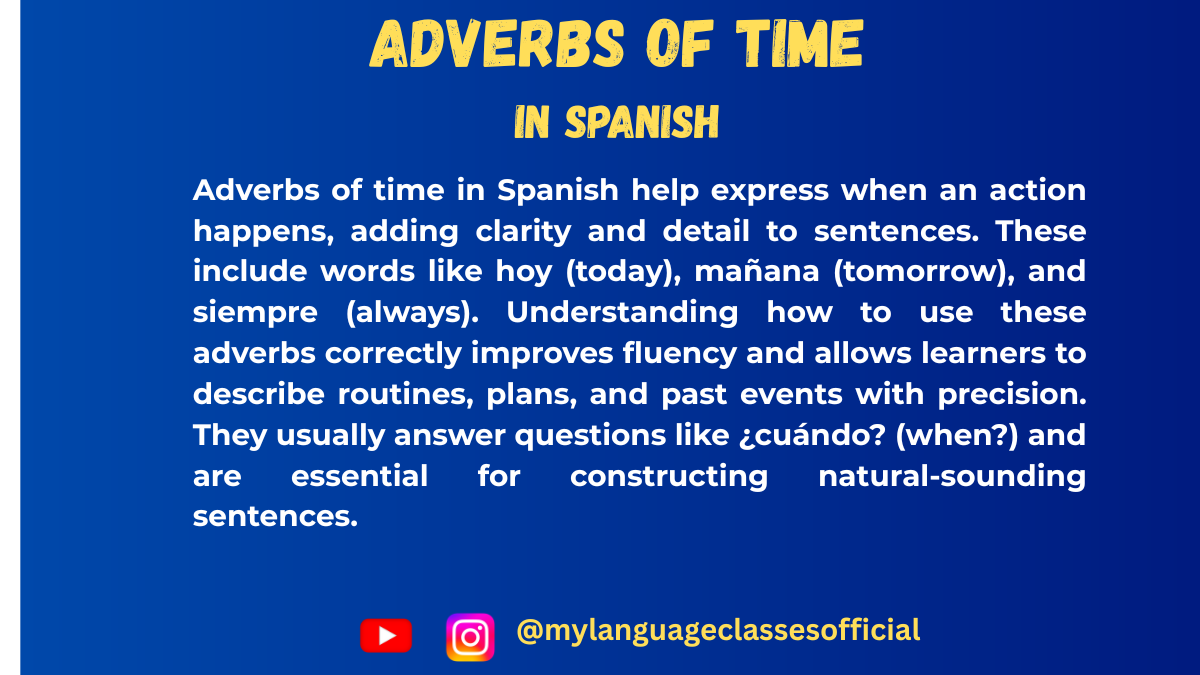
Adverbs of Time in Spanish: A Complete Guide
Adverbs of time (“los adverbios de tiempo”) are essential in Spanish to indicate when an action takes place. They help provide clarity and context to sentences, making conversations more precise. In this article, we will explore common Spanish adverbs of time, their meanings, examples, and grammatical considerations.
What Are Adverbs of Time?
Adverbs of time modify verbs, adjectives, or other adverbs by indicating the timing of an action. They answer questions like ¿Cuándo? (When?) and ¿Cada cuánto tiempo? (How often?).
Common Spanish Adverbs of Time
Here is a list of frequently used adverbs of time in Spanish along with their meanings and example sentences:
1. Adverbs for Specific Points in Time
- Hoy (Today)
- Hoy es un día especial. (Today is a special day.)
- Mañana (Tomorrow)
- Mañana voy al médico. (Tomorrow I am going to the doctor.)
- Ayer (Yesterday)
- Ayer llovió mucho. (Yesterday it rained a lot.)
- Ahora (Now)
- Ahora estoy ocupado. (Now I am busy.)
- Luego (Later)
- Voy al cine, luego te llamo. (I am going to the cinema, later I will call you.)
- Antes (Before)
- Antes de salir, apaga la luz. (Before leaving, turn off the light.)
- Después (After)
- Después de cenar, salimos a caminar. (After dinner, we go for a walk.)
2. Adverbs for Frequency
- Siempre (Always)
- Siempre me levanto temprano. (I always wake up early.)
- Nunca / Jamás (Never)
- Nunca fumo. (I never smoke.)
- Jamás lo volveré a hacer. (I will never do it again.)
- A menudo (Often)
- Voy al gimnasio a menudo. (I go to the gym often.)
- De vez en cuando (From time to time)
- De vez en cuando voy al teatro. (From time to time, I go to the theater.)
- Raramente (Rarely)
- Raramente veo televisión. (I rarely watch TV.)
- Casi nunca (Almost never)
- Casi nunca como comida rápida. (I almost never eat fast food.)
3. Adverbs for Duration
- Todavía / Aún (Still, yet)
- Todavía no he terminado. (I have not finished yet.)
- Ya (Already)
- Ya terminé la tarea. (I already finished the homework.)
- Por fin / Finalmente (Finally)
- Finalmente llegó el paquete. (The package finally arrived.)
- Desde entonces (Since then)
- Desde entonces no hemos hablado. (Since then, we have not spoken.)
- Mientras (While)
- Escucho música mientras estudio. (I listen to music while I study.)
Grammar and Usage Considerations
1. Placement in a Sentence
- In most cases, adverbs of time appear at the beginning or the end of a sentence:
- Hoy tengo clases. (Today I have classes.)
- Tengo clases hoy. (I have classes today.)
- Some adverbs, like ya, are placed before the verb:
- Ya terminé mi trabajo. (I already finished my work.)
2. Agreement and Gender Considerations
- Unlike adjectives, adverbs do not change in gender or number.
- However, some time expressions require articles or prepositions, such as:
- El lunes pasado (Last Monday) vs. Los lunes (On Mondays)
- En la mañana (In the morning) vs. Por la mañana (During the morning)
Forming Adverbs of Time from Adjectives
1. Regular Formation (Adding -mente)
Many adverbs are formed by adding -mente to the feminine singular form of adjectives:
- Rápido (Fast) → Rápidamente (Quickly)
- Frecuente (Frequent) → Frecuentemente (Frequently)
2. Irregular Formation
Some adverbs do not follow the regular -mente rule and must be memorized:
- Bien (Well), Mal (Badly), Tarde (Late), Temprano (Early)
- Example: Él llegó tarde a la reunión. (He arrived late to the meeting.)
3. Using Prepositional Phrases as Adverbs of Time
Some expressions function as adverbs when combined with prepositions:
- De vez en cuando (From time to time)
- Cada día (Every day)
- Hace un rato (A while ago)
Common Mistakes to Avoid
- Confusing “ya” and “todavía”:
- Ya means “already”: Ya hice mi tarea. (I already did my homework.)
- Todavía means “still”: Todavía estoy haciendo mi tarea. (I am still doing my homework.)
- Misplacing “nunca” in negative sentences:
- Correct: Nunca he estado en España. (I have never been to Spain.)
- Incorrect: No he estado nunca en España. (Although this is sometimes used in spoken Spanish, it’s not grammatically preferred.)
Conclusion
Adverbs of time are fundamental for constructing clear and accurate sentences in Spanish. Understanding their placement, variations, and common expressions will enhance your fluency. By practicing these adverbs in different contexts, you will develop a more natural and precise way of speaking Spanish.
If you enjoyed this lesson, be sure to check out more posts like this on my blog at My Language Classes. Don’t forget to subscribe my YouTube channel and follow me on Instagram for the latest language learning tips and lessons. Leave a comment below to share your thoughts, or ask any questions you have.
Happy learning! 😊
- Hoy (Today)
-
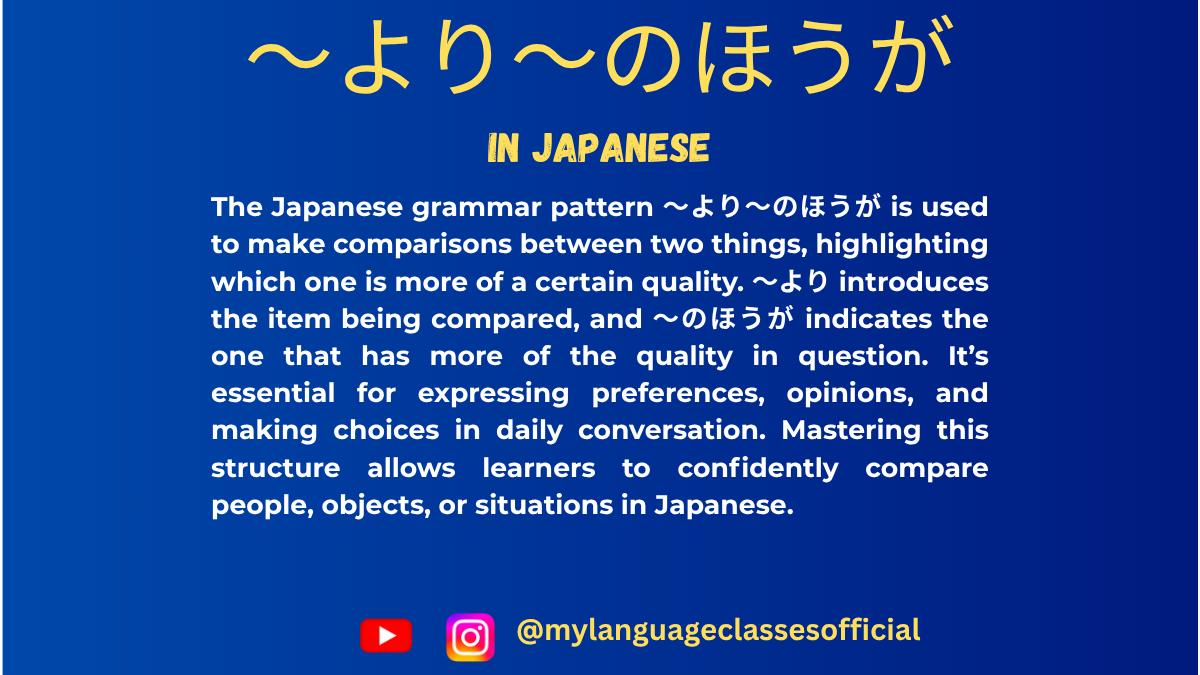
Understanding 〜より〜のほうが in Japanese | My Language Classes
Understanding 〜より〜のほうが
The construction 〜より〜のほうが is an essential tool in Japanese for making comparisons. It translates to “X is more than Y” or “X is better/more suitable than Y” and is widely used in everyday conversations, formal contexts, and written communication. This blog post dives into its meaning, usage, and various scenarios.
Structure of 〜より〜のほうが
The pattern is straightforward:
- Yより Xのほうが adjective/descriptive phrase.
- Yより: Indicates the thing being compared (Y).
- Xのほうが: Highlights the preferred or superior item (X).
Example:
- 犬より猫のほうが好きです。
(I like cats more than dogs.)
Core Uses of 〜より〜のほうが
- Preference
When expressing a preference between two items, activities, or options:- 旅行より勉強のほうが楽しいです。
(Studying is more fun than traveling.)
- 旅行より勉強のほうが楽しいです。
- Quantitative Comparisons
Highlighting differences in measurable qualities like size, speed, or price:- バスより電車のほうが早いです。
(Trains are faster than buses.) - このレストランよりあのレストランのほうが安いです。
(That restaurant is cheaper than this one.)
- バスより電車のほうが早いです。
- Capabilities
Used to compare abilities or skills:- 英語より日本語のほうが得意です。
(I’m better at Japanese than English.)
- 英語より日本語のほうが得意です。
- Frequency or Intensity
Comparing how often or how strongly something occurs:- 冬より夏のほうが好きです。
(I like summer more than winter.)
- 冬より夏のほうが好きです。
- Hypotheticals
For discussing hypothetical preferences or outcomes:- 映画館より家で映画を見たほうがいいです。
(Watching a movie at home is better than going to the cinema.)
- 映画館より家で映画を見たほうがいいです。
- Suitability
Indicating one option is more suitable for a specific purpose:- この仕事には男性より女性のほうが適しています。
(For this job, women are more suitable than men.)
- この仕事には男性より女性のほうが適しています。
Situations Where 〜より〜のほうが is Used
- Daily Conversations
- Comparing food, hobbies, weather, or locations:
- 寿司よりラーメンのほうがおいしいと思います。
(I think ramen is tastier than sushi.)
- 寿司よりラーメンのほうがおいしいと思います。
- Comparing food, hobbies, weather, or locations:
- Business and Professional Settings
- Discussing product qualities or work efficiency:
- この方法よりその方法のほうが効率的です。
(That method is more efficient than this one.)
- この方法よりその方法のほうが効率的です。
- Discussing product qualities or work efficiency:
- Travel and Leisure
- Comparing destinations, travel modes, or activities:
- 海外旅行より国内旅行のほうが安心です。
(Domestic travel is safer than international travel.)
- 海外旅行より国内旅行のほうが安心です。
- Comparing destinations, travel modes, or activities:
- Education and Learning
- Comparing subjects or teaching methods:
- 自習より先生に教えてもらうほうがいいです。
(Being taught by a teacher is better than self-study.)
- 自習より先生に教えてもらうほうがいいです。
- Comparing subjects or teaching methods:
- Relationships and Social Scenarios
- Evaluating people or interpersonal qualities:
- 彼より彼女のほうが優しいです。
(She is kinder than him.)
- 彼より彼女のほうが優しいです。
- Evaluating people or interpersonal qualities:
Key Notes
- Implied Context:
In conversational Japanese, the context often allows for the omission of repetitive elements:- 映画よりドラマのほうが好きです。(I like dramas more than movies.)
Can be shortened to:- ドラマのほうが好きです。 (I like dramas more.)
- 映画よりドラマのほうが好きです。(I like dramas more than movies.)
- Neutrality:
The phrase is neutral and doesn’t carry judgmental connotations, making it versatile for all scenarios. - Politeness Levels:
Depending on the situation, you can adjust politeness levels:- Casual: 〜より〜のほうがいい。
- Polite: 〜より〜のほうがいいです。
- Formal: 〜より〜のほうが適切です。
Practice Examples
- 自転車より車のほうが速いです。
(Cars are faster than bicycles.) - テレビを見るより本を読むほうがいいです。
(Reading books is better than watching TV.) - 東京より大阪のほうが住みやすいと思います。
(I think Osaka is easier to live in than Tokyo.)
By mastering 〜より〜のほうが, you can convey nuanced preferences and comparisons effectively. Practice using it in different contexts to build fluency!
What comparisons will you try making today? Let me know in the comments!
If you enjoyed this lesson, be sure to check out more posts like this on my blog at My Language Classes. Don’t forget to subscribe my YouTube channel and follow me on Instagram for the latest language learning tips and lessons. Leave a comment below to share your thoughts, or ask any questions you have about nouns.
Happy learning! 😊
- Yより Xのほうが adjective/descriptive phrase.
-
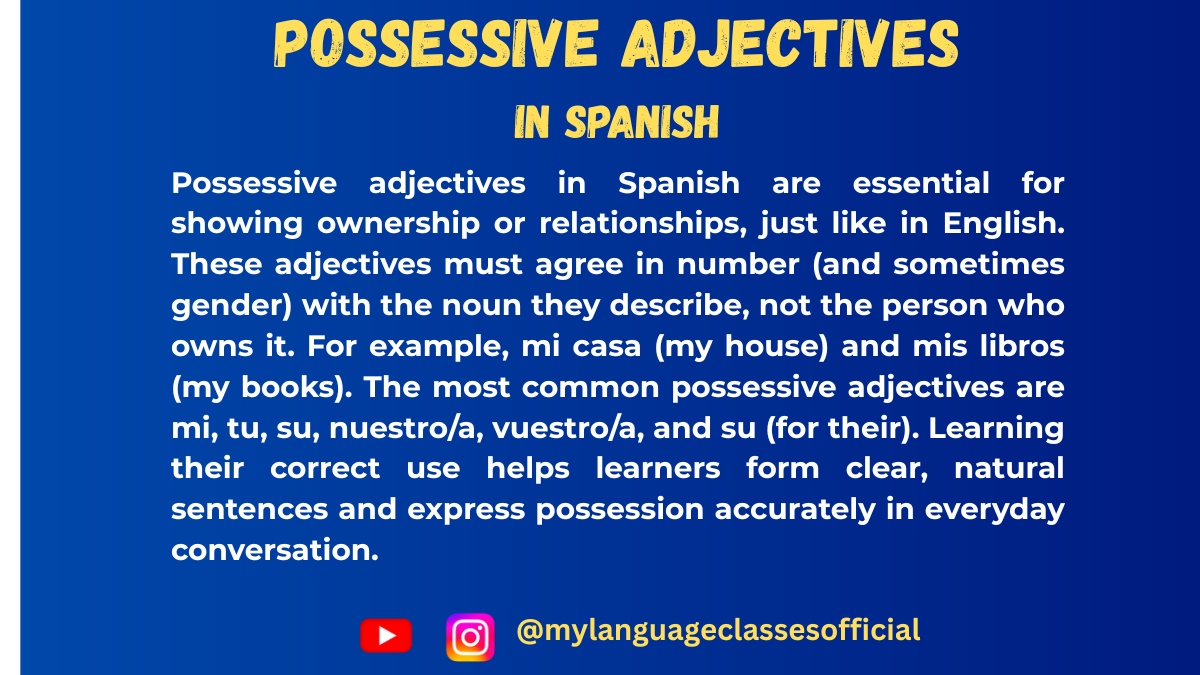
Possessive Adjectives in Spanish
Possessive adjectives in Spanish are essential for indicating ownership or relationships. They agree in gender and number with the noun they modify and are categorized into two forms: short-form possessive adjectives and long-form possessive adjectives.
Short-Form Possessive Adjectives
These adjectives come before the noun and agree only in number (except for “nuestro” and “vuestro,” which also agree in gender).
Singular Possessor Singular Noun Plural Noun mi (my) mi casa (my house) mis casas (my houses) tu (your, informal) tu coche (your car) tus coches (your cars) su (his, her, its, your formal) su perro (his dog) sus perros (his dogs) nuestro/a (our) nuestro amigo (our friend) nuestros amigos (our friends) vuestro/a (your, plural informal) vuestra madre (your mother) vuestras madres (your mothers) su (their, your plural formal) su profesor (their teacher) sus profesores (their teachers) Examples Sentences:
- Mi casa es grande. (My house is big.)
- Tus zapatos son nuevos. (Your shoes are new.)
- Su hermano vive en Madrid. (His brother lives in Madrid.)
- Nuestra escuela es moderna. (Our school is modern.)
- Vuestras mochilas están en la mesa. (Your backpacks are on the table.)
- Sus ideas son interesantes. (Their ideas are interesting.)
Long-Form Possessive Adjectives
These adjectives come after the noun and agree in both gender and number with the noun. They emphasize ownership.
Singular Possessor Singular Masculine Singular Feminine Plural Masculine Plural Feminine mío/a (mine) el libro mío (my book) la casa mía (my house) los libros míos (my books) las casas mías (my houses) tuyo/a (yours, informal) el coche tuyo (your car) la bolsa tuya (your bag) los coches tuyos (your cars) las bolsas tuyas (your bags) suyo/a (his, hers, yours formal) el perro suyo (his dog) la idea suya (her idea) los perros suyos (his dogs) las ideas suyas (her ideas) nuestro/a (ours) el amigo nuestro (our friend) la profesora nuestra (our teacher) los amigos nuestros (our friends) las profesoras nuestras (our teachers) vuestro/a (yours, plural informal) el coche vuestro (your car) la casa vuestra (your house) los coches vuestros (your cars) las casas vuestras (your houses) suyo/a (theirs, yours plural formal) el libro suyo (their book) la comida suya (their food) los libros suyos (their books) las comidas suyas (their foods) Examples Sentences:
- Esa mochila es mía. (That backpack is mine.)
- El coche rojo es tuyo. (The red car is yours.)
- La casa grande es suya. (The big house is his/hers.)
- La responsabilidad es nuestra. (The responsibility is ours.)
- El problema es vuestro. (The problem is yours.)
- Las ideas son suyas. (The ideas are theirs.)
Key Differences Between Short and Long Forms
- Position in the sentence: Short forms come before the noun; long forms come after the noun.
- Emphasis: Long forms emphasize possession and ownership more strongly.
- Agreement: Long forms agree in both gender and number, whereas short forms only change for number (except “nuestro” and “vuestro”).
Common Expressions Using Possessive Adjectives
Here are some useful phrases commonly used in daily life:
Spanish English Mi amor My love Mi casa es tu casa My house is your house (Feel at home) A su servicio At your service En su tiempo libre In his/her free time A mi manera In my way A su gusto To his/her liking Nuestros pensamientos Our thoughts Vuestra responsabilidad Your responsibility Lo mío es importante What is mine is important Un amigo mío A friend of mine Example Sentences Using Expressions:
- Mi casa es tu casa, siéntete cómodo. (My house is your house, make yourself comfortable.)
- A su gusto, puede elegir cualquier opción. (To his/her liking, they can choose any option.)
- En su tiempo libre, le gusta leer. (In his/her free time, he/she likes to read.)
- Nuestros pensamientos son similares. (Our thoughts are similar.)
Things to Keep in Mind When Using Possessive Adjectives
- Article Usage: Short-form possessive adjectives do not need an article, while long-form adjectives can be used with definite articles (el, la, los, las):
- Mi coche es rojo. (My car is red.)
- El coche mío es rojo. (The car of mine is red.)
- Plural and Gender Agreement:
- If the noun is plural, the possessive adjective must be plural.
- If the noun is feminine, adjectives ending in -o change to -a (e.g., “mío” → “mía”).
- Ambiguity of “su/sus”: “Su” and “sus” can mean “his, her, their, your (formal),” leading to confusion. To clarify, use “de + pronoun/name”:
- Su coche es nuevo. (His/her/your/their car is new.)
- El coche de Juan es nuevo. (Juan’s car is new.)
- El coche de ellos es nuevo. (Their car is new.)
Final Thoughts
Possessive adjectives are an integral part of Spanish grammar, making conversations clearer and more precise. Understanding the difference between short and long forms, as well as their proper agreement with nouns, will greatly improve your fluency. Practice using these adjectives in daily conversations, and soon, they’ll become second nature!
Did you find this guide helpful?
Let us know in the comments below or practice by writing a few sentences using possessive adjectives!
If you enjoyed this lesson, be sure to check out more posts like this on my blog at My Language Classes. Don’t forget to subscribe my YouTube channel and follow me on Instagram for the latest language learning tips and lessons. Leave a comment below to share your thoughts, or ask any questions you have.
Happy learning! 😊
-

Understanding “〜てはいけない” in Japanese | My Language Classes
How to Use 〜てはいけない
The phrase “〜てはいけない” is a common Japanese grammatical structure used to express prohibition, or things that are not allowed. It translates to “must not” or “cannot” in English. This phrase is widely used in various contexts, from giving instructions to setting rules.
Formation of 〜てはいけない
The structure “〜てはいけない” is formed by attaching て-form of a verb to はいけない. Here’s how it works:
- Convert the verb to its て-form.
- Add はいけない to the end of the verb.
Example:
- 食べる (to eat) → 食べてはいけない (must not eat)
- 行く (to go) → 行ってはいけない (must not go)
Situations Where “〜てはいけない” is Used
- Rules and Regulations
Used to express prohibitions in formal and informal rules:- 学校で携帯電話を使ってはいけない。
(You must not use mobile phones at school.) - ここでタバコを吸ってはいけません。
(You must not smoke here.)
- 学校で携帯電話を使ってはいけない。
- Giving Orders or Instructions
Often used in scenarios where instructions need to be clear:- 試験中に話してはいけない。
(You must not talk during the exam.) - このドアを開けてはいけません。
(You must not open this door.)
- 試験中に話してはいけない。
- Moral or Ethical Prohibitions
Refers to socially unacceptable behaviors:- 他人のものを勝手に使ってはいけない。
(You must not use someone else’s belongings without permission.) - 嘘をついてはいけません。
(You must not lie.)
- 他人のものを勝手に使ってはいけない。
- Safety Warnings
Used to highlight actions that could lead to danger:- この薬を飲んでお酒を飲んではいけません。
(You must not drink alcohol after taking this medicine.) - 火のそばで遊んではいけない。
(You must not play near fire.)
- この薬を飲んでお酒を飲んではいけません。
- Expressing Social Norms
Indicates socially expected behaviors or taboos:- ご飯を食べながらしゃべってはいけません。
(You must not talk while eating.)
- ご飯を食べながらしゃべってはいけません。
- Parent-Child or Teacher-Student Scenarios
Frequently used in educational or authoritative contexts:- 遅くまでテレビを見てはいけない。
(You must not watch TV until late.) - 宿題を忘れてはいけません。
(You must not forget your homework.)
- 遅くまでテレビを見てはいけない。
Points to Remember
- Polite Variations
In formal or polite speech, いけない can be replaced with いけません:- ここに入ってはいけません。
(You must not enter here.)
- ここに入ってはいけません。
- Casual Variations
In casual speech, てはいけない may become ちゃいけない or じゃいけない:- そんなことしちゃいけないよ!
(You shouldn’t do that!)
- そんなことしちゃいけないよ!
- Cultural Context
Understanding when to use “〜てはいけない” depends on the context. Japanese culture often emphasizes politeness and indirectness. Therefore, use polite forms in formal settings to avoid sounding harsh.
Examples of Verbs and Usage
Verb (Dictionary Form) て-Form Usage Example 飲む (to drink) 飲んで お酒を飲んではいけない。(You must not drink alcohol.) 遊ぶ (to play) 遊んで 道路で遊んではいけない。(You must not play on the road.) 書く (to write) 書いて 壁に書いてはいけません。(You must not write on the wall.) 行く (to go) 行って 危険な場所に行ってはいけない。(You must not go to dangerous places.) 話す (to talk) 話して 授業中に話してはいけません。(You must not talk during class.)
List of Situations for “〜てはいけない”
- At school (e.g., no phones, no talking during tests)
- At work (e.g., no eating at desks, no accessing unauthorized files)
- Public spaces (e.g., no littering, no smoking in non-smoking zones)
- During social interactions (e.g., no interrupting others, no offensive comments)
- While driving (e.g., no using phones, no speeding)
- At home (e.g., no playing with dangerous tools, no staying up too late)
- With safety rules (e.g., no entering restricted areas, no consuming certain substances)
By understanding and mastering the use of “〜てはいけない,” you can effectively communicate prohibitions and rules in Japanese. This structure is crucial for clear, polite, and culturally appropriate expressions in both written and spoken Japanese.
If you enjoyed this lesson, be sure to check out more posts like this on my blog at My Language Classes. Don’t forget to subscribe my YouTube channel and follow me on Instagram for the latest language learning tips and lessons. Leave a comment below to share your thoughts, or ask any questions you have about nouns.
Happy learning! 😊
-
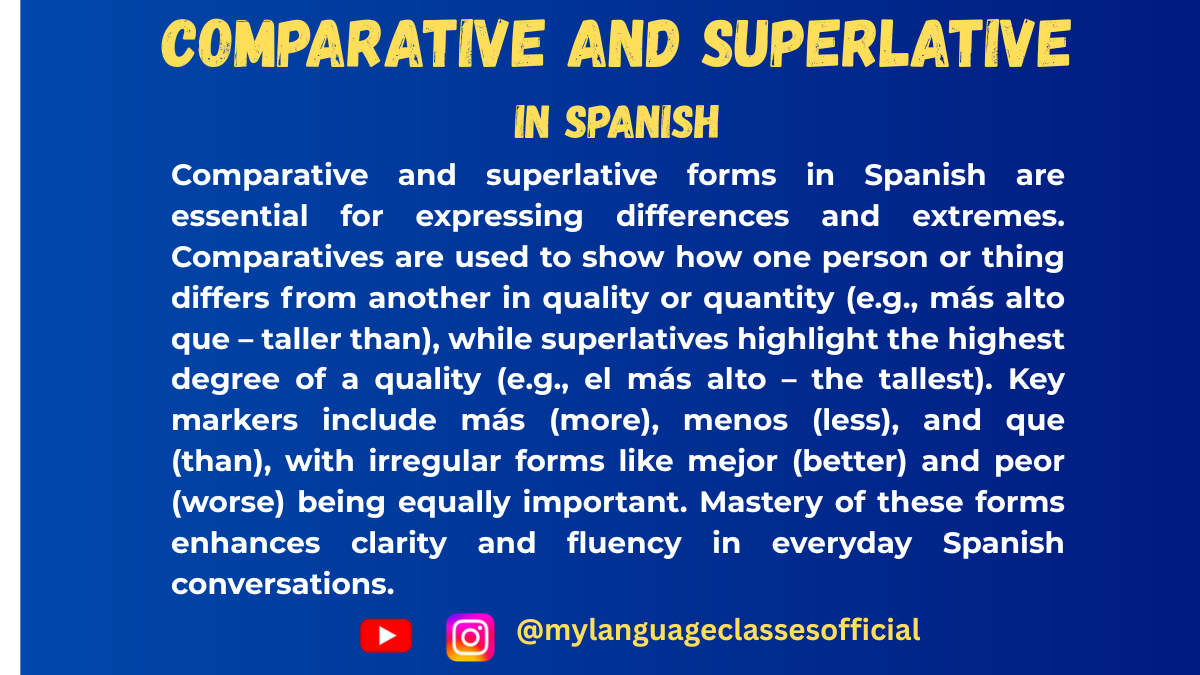
Comparative and Superlative Forms of Adjectives in Spanish
Adjectives in Spanish are essential for describing people, places, and things. Understanding how to form and use comparative and superlative adjectives is crucial for effective communication, especially when comparing or emphasizing characteristics.
Comparative Forms of Adjectives
Comparative adjectives are used to compare two entities. In Spanish, there are three types:
- Comparative of Superiority (more than): más + adjective + que
- Comparative of Equality (as…as): tan + adjective + como
- Comparative of Inferiority (less than): menos + adjective + que
Superlative Forms of Adjectives
Superlatives express the highest or lowest degree of a quality. There are two types:
- Relative Superlative: Used to indicate “the most” or “the least” within a group.
- Formula: el/la/los/las + más/menos + adjective + de
- Absolute Superlative: Used to indicate “very” or “extremely” without comparison.
- Formula: Add -ísimo/a/os/as to the adjective. For example, alto → altísimo.
Key Points to Remember
- Gender and Plurality:
Adjectives must agree in gender (masculine/feminine) and number (singular/plural) with the noun they modify.- Examples:
- El coche más rápido. (The fastest car.)
- Las casas más grandes. (The biggest houses.)
- Examples:
- Articles in Superlatives:
Use the definite article (el, la, los, las) before the superlative form to specify the subject.- Example: Es la persona más amable. (She is the kindest person.)
- Irregular Adjectives:
Some adjectives have irregular comparative and superlative forms that don’t follow standard rules.
Forming Comparatives and Superlatives
Regular Adjectives
- Más + adjective + que
- Example: Pedro es más alto que Juan. (Pedro is taller than Juan.)
- Tan + adjective + como
- Example: María es tan inteligente como Ana. (María is as intelligent as Ana.)
- Menos + adjective + que
- Example: Este libro es menos interesante que ese. (This book is less interesting than that one.)
Irregular Adjectives
Some adjectives have unique forms:
- Bueno (good) → mejor (better) → el mejor (the best)
- Malo (bad) → peor (worse) → el peor (the worst)
- Grande (big) → mayor (bigger/older) → el mayor (the biggest/oldest)
- Pequeño (small) → menor (smaller/younger) → el menor (the smallest/youngest)
List of Common Adjectives with Comparative and Superlative Forms
Adjective Comparative Superlative Example Sentence Alto (tall) más alto el más alto Juan es más alto que Pedro. (Juan is taller than Pedro.) Bajo (short) menos bajo el menos bajo Luis es el menos bajo del grupo. (Luis is the shortest in the group.) Bueno (good) mejor el mejor Este libro es mejor que el otro. (This book is better than the other.) Malo (bad) peor el peor Ese día fue el peor de mi vida. (That day was the worst of my life.) Grande (big) mayor el mayor Ella es la mayor de sus hermanas. (She is the oldest of her sisters.) Pequeño (small) menor el menor Este cuarto es el menor de todos. (This room is the smallest of all.)
Daily Expressions Using Comparatives and Superlatives
Spanish Expression Translation Example Sentence Más vale tarde que nunca. Better late than never. Llegaste tarde, pero más vale tarde que nunca. El más mínimo detalle. The slightest detail. No olvides el más mínimo detalle. Es peor el remedio que la enfermedad. The cure is worse than the disease. No aceptes esa solución, es peor el remedio que la enfermedad.
Common Situations for Usage
- Describing People:
- Ella es más simpática que su hermana. (She is nicer than her sister.)
- Talking About Places:
- Este restaurante es el más famoso de la ciudad. (This restaurant is the most famous in the city.)
- Comparing Objects:
- Este coche es mejor que aquel. (This car is better than that one.)
Tips for Mastery
- Memorize Irregular Forms: Focus on learning irregular adjectives as they’re used frequently.
- Practice Gender Agreement: Always match adjectives to the gender and number of the noun.
- Use Common Expressions: Integrating idiomatic expressions into your speech will make you sound more natural.
With consistent practice and attention to detail, mastering comparative and superlative adjectives in Spanish becomes an achievable goal!
If you enjoyed this lesson, be sure to check out more posts like this on my blog at My Language Classes. Don’t forget to subscribe my YouTube channel and follow me on Instagram for the latest language learning tips and lessons. Leave a comment below to share your thoughts, or ask any questions you have.
Happy learning! 😊
-

Modal Verbs in Spanish: A Complete Guide
Modal verbs in Spanish, known as verbos modales, are auxiliary verbs that help express necessity, ability, permission, obligation, or possibility. Just like in English, they are followed by an infinitive verb and modify its meaning. Understanding these verbs is essential for mastering Spanish and communicating effectively in daily situations.
Common Modal Verbs in Spanish
Here are the most frequently used modal verbs in Spanish:
- Poder (to be able to, can) – Expresses ability or permission
- Querer (to want, to wish) – Indicates desire or intention
- Deber (must, should, ought to) – Expresses obligation or probability
- Tener que (to have to) – Indicates necessity or obligation
- Haber de (to have to, should) – Expresses mild obligation or intention
- Saber (to know how to) – Expresses ability when used with an infinitive
- Soler (to usually do something) – Describes habitual actions
Usage and Sentence Structures
1. Poder – Expressing Ability and Permission
Conjugation Example (Present Tense):
- Yo puedo
- Tú puedes
- Él/Ella/Usted puede
- Nosotros/Nosotras podemos
- Vosotros/Vosotras podéis
- Ellos/Ellas/Ustedes pueden
Example Sentences:
- Puedo hablar español. (I can speak Spanish.)
- ¿Puedes ayudarme? (Can you help me?)
- No puedes entrar sin permiso. (You cannot enter without permission.)
2. Querer – Expressing Desire or Intention
Conjugation Example (Present Tense):
- Yo quiero
- Tú quieres
- Él/Ella/Usted quiere
- Nosotros/Nosotras queremos
- Vosotros/Vosotras queréis
- Ellos/Ellas/Ustedes quieren
Example Sentences:
- Quiero aprender español. (I want to learn Spanish.)
- ¿Quieres un café? (Do you want a coffee?)
- Ella quiere viajar por el mundo. (She wants to travel around the world.)
3. Deber – Expressing Obligation or Probability
Conjugation Example (Present Tense):
- Yo debo
- Tú debes
- Él/Ella/Usted debe
- Nosotros/Nosotras debemos
- Vosotros/Vosotras debéis
- Ellos/Ellas/Ustedes deben
Example Sentences:
- Debes estudiar más. (You should study more.)
- Debemos respetar a los demás. (We must respect others.)
- Esto debe ser importante. (This must be important.)
4. Tener que – Expressing Necessity
Conjugation Example (Present Tense):
- Yo tengo que
- Tú tienes que
- Él/Ella/Usted tiene que
- Nosotros/Nosotras tenemos que
- Vosotros/Vosotras tenéis que
- Ellos/Ellas/Ustedes tienen que
Example Sentences:
- Tengo que trabajar mañana. (I have to work tomorrow.)
- ¿Tienes que irte ahora? (Do you have to leave now?)
- Ellos tienen que hacer la tarea. (They have to do their homework.)
5. Haber de – Expressing Mild Obligation or Intention
Example Sentences:
- He de llamarte más tarde. (I have to call you later.)
- Has de saber la verdad. (You should know the truth.)
6. Saber – Expressing Ability or Knowledge
Example Sentences:
- Sé nadar muy bien. (I know how to swim very well.)
- ¿Sabes tocar la guitarra? (Do you know how to play the guitar?)
7. Soler – Expressing Habitual Actions
Example Sentences:
- Suelo levantarme temprano. (I usually wake up early.)
- ¿Sueles ir al gimnasio? (Do you usually go to the gym?)
Conjugation and Verb Formation Rules
Regular Verb Conjugation in Present Tense
AR verbs: hablar (to speak)
- Yo hablo
- Tú hablas
- Él/Ella/Usted habla
- Nosotros/Nosotras hablamos
- Vosotros/Vosotras habláis
- Ellos/Ellas/Ustedes hablan
ER verbs: comer (to eat)
- Yo como
- Tú comes
- Él/Ella/Usted come
- Nosotros/Nosotras comemos
- Vosotros/Vosotras coméis
- Ellos/Ellas/Ustedes comen
IR verbs: vivir (to live)
- Yo vivo
- Tú vives
- Él/Ella/Usted vive
- Nosotros/Nosotras vivimos
- Vosotros/Vosotras vivís
- Ellos/Ellas/Ustedes viven
Irregular Modal Verbs Conjugation in Present Tense
Poder (o→ue change)
- Yo puedo
- Tú puedes
- Él/Ella/Usted puede
- Nosotros/Nosotras podemos
- Vosotros/Vosotras podéis
- Ellos/Ellas/Ustedes pueden
Querer (e→ie change)
- Yo quiero
- Tú quieres
- Él/Ella/Usted quiere
- Nosotros/Nosotras queremos
- Vosotros/Vosotras queréis
- Ellos/Ellas/Ustedes quieren
Things to Keep in Mind
- Articles and Gender: Modal verbs are always followed by an infinitive verb, but nouns used in the sentence must agree in gender and number.
- Example: Debes comprar la mesa (You must buy the table – ‘mesa’ is feminine).
- Plurality: Modal verbs do not change based on the plurality of the infinitive verb.
- Example: Puedes comprar los libros (You can buy the books).
- Sentence Structure: Modal verbs follow a Subject + Modal Verb + Infinitive structure.
- Example: Ella quiere bailar (She wants to dance).
Conclusion
Mastering modal verbs in Spanish is crucial for fluency and natural conversation. Whether you’re asking for permission, expressing obligation, or stating an ability, these verbs will help you communicate effectively. Keep practicing their conjugations and use them in real-life situations to improve your Spanish proficiency!
If you enjoyed this lesson, be sure to check out more posts like this on my blog at My Language Classes. Don’t forget to subscribe my YouTube channel and follow me on Instagram for the latest language learning tips and lessons. Leave a comment below to share your thoughts, or ask any questions you have.
Happy learning! 😊
-
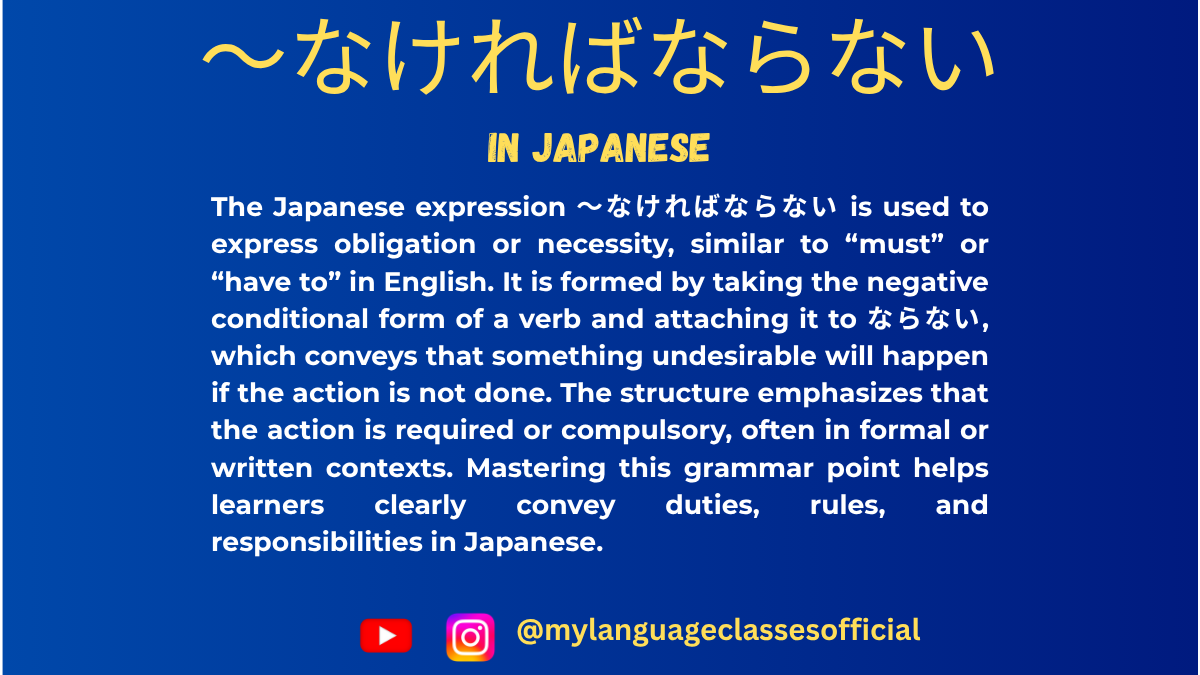
Understanding 〜なければならない in Japanese | My Language Classes
How to Use 〜なければならないin Japanese
The phrase 〜なければならない is a commonly used Japanese grammar structure that expresses obligation or necessity, similar to “must” or “have to” in English. It’s essential for learners to master this phrase because it is frequently used in both formal and casual settings.
Structure of 〜なければならない
- Verb in the Negative Form + なければならない
- Example: 行く → 行かなければならない
(iku → ikanakereba naranai)- Meaning: “I must go.”
- Example: 行く → 行かなければならない
- Conjugation Steps:
- Take the negative form of the verb (ない form).
- Replace ない with なければならない.
Variations of 〜なければならない
- 〜なければいけない
- Another common form with the same meaning.
- Slightly softer in tone.
- 〜なくてはならない
- Less commonly used in casual conversation but often appears in written or formal contexts.
- 〜なくてはいけない
- Similar to 〜なければいけない and used in formal or polite speech.
Situations Where 〜なければならない is Used
Here’s a list of situations where this grammar is appropriate:
1. Rules and Regulations
- Expressing obligations based on rules or laws.
- Example:
- 学校に行かなければならない。
(Gakkou ni ikanakereba naranai.)- Meaning: “I must go to school.”
- 学校に行かなければならない。
2. Work and Responsibilities
- Talking about duties or tasks that must be completed.
- Example:
- 仕事を終わらせなければならない。
(Shigoto o owarasena kereba naranai.)- Meaning: “I must finish the work.”
- 仕事を終わらせなければならない。
3. Social and Cultural Expectations
- Highlighting social norms or obligations.
- Example:
- 礼儀を守らなければならない。
(Reigi o mamorana kereba naranai.)- Meaning: “I must observe proper manners.”
- 礼儀を守らなければならない。
4. Personal Commitments
- Expressing personal resolutions or goals.
- Example:
- ダイエットのために運動しなければならない。
(Daietto no tame ni undou shinakereba naranai.)- Meaning: “I must exercise for my diet.”
- ダイエットのために運動しなければならない。
5. Health and Safety
- Discussing health-related necessities.
- Example:
- 健康のために野菜を食べなければならない。
(Kenkou no tame ni yasai o tabena kereba naranai.)- Meaning: “I must eat vegetables for my health.”
- 健康のために野菜を食べなければならない。
6. Moral or Ethical Obligations
- Talking about what is morally right.
- Example:
- 嘘をついてはいけないし、謝らなければならない。
(Uso o tsuite wa ikenai shi, ayamaranakereba naranai.)- Meaning: “I must not lie, and I must apologize.”
- 嘘をついてはいけないし、謝らなければならない。
7. Deadlines and Time-Sensitive Tasks
- When tasks need to be completed by a specific time.
- Example:
- 今週末までにレポートを提出しなければならない。
(Konshuumatsu made ni repooto o teishutsu shinakereba naranai.)- Meaning: “I must submit the report by this weekend.”
- 今週末までにレポートを提出しなければならない。
Key Points to Remember
- Formality:
- 〜なければならない is slightly more formal than 〜なければいけない. Use it in professional or formal writing.
- Alternative Expressions:
- In casual settings, people often shorten the phrase to 〜なきゃ or 〜なくちゃ.
- Example: 勉強しなきゃいけない (Benkyou shinakya ikenai) = “I must study.”
- In casual settings, people often shorten the phrase to 〜なきゃ or 〜なくちゃ.
- Cultural Context:
- Japanese culture values politeness and rules, so this structure is vital for expressing respect towards societal norms.
- Flexibility:
- While the grammar indicates obligation, tone and context can soften its intensity. For example, “You must” may sound harsh in English, but in Japanese, it’s often a gentle reminder or encouragement.
Practice Exercises
- Convert the following sentences into 〜なければならない form:
- 私は毎日運動する。
- 宿題をする。
- 早く起きる。
- Translate into Japanese:
- I must visit the doctor tomorrow.
- We have to clean the house by this evening.
- Imagine you are living in Japan. Write three sentences about what you “must” do in daily life using 〜なければならない.
Mastering 〜なければならない is crucial for understanding how to express obligations in Japanese effectively. Start using it in your conversations and writing to become more natural and fluent!
If you enjoyed this lesson, be sure to check out more posts like this on my blog at My Language Classes. Don’t forget to subscribe my YouTube channel and follow me on Instagram for the latest language learning tips and lessons. Leave a comment below to share your thoughts, or ask any questions you have about nouns.
Happy learning! 😊
- Verb in the Negative Form + なければならない
-
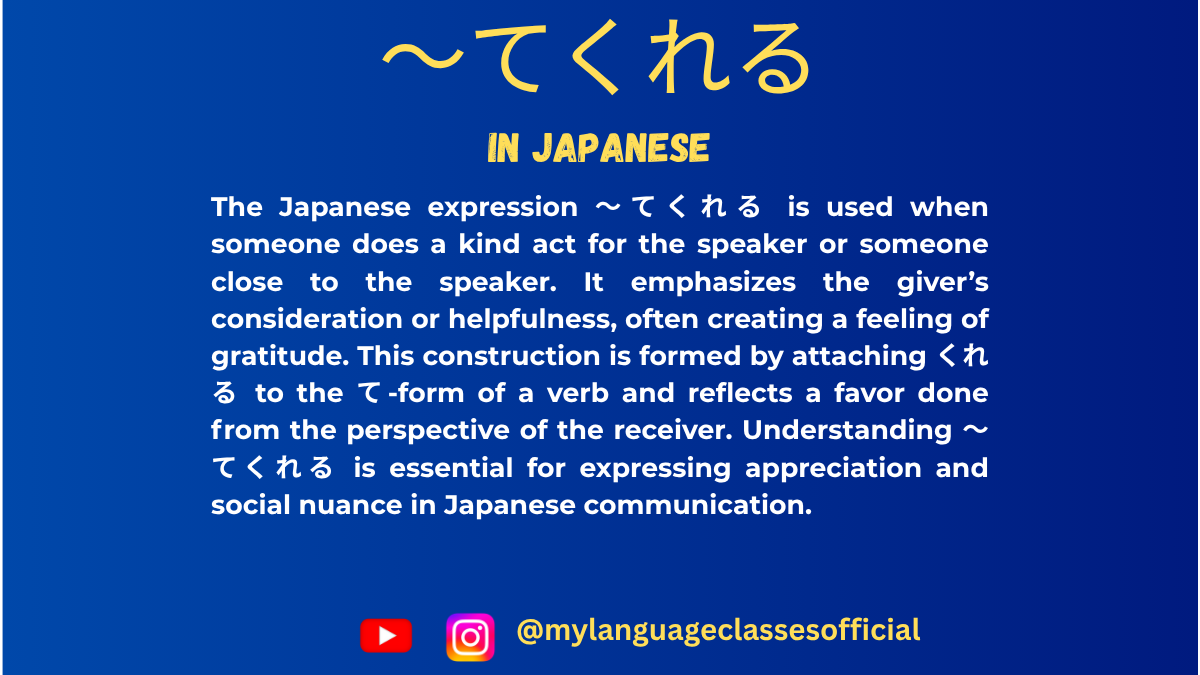
How to Use 〜てくれる | My Language Classes
Understanding “〜てくれる” in Japanese
The Japanese expression 〜てくれる is a key grammatical structure used to describe actions done for the speaker’s benefit or someone close to them. It conveys gratitude and appreciation towards the doer. Let’s explore its usage in various contexts and provide a list of situations where “〜てくれる” is used.
What is 〜てくれる?
“〜てくれる” is derived from the verb くれる, which means “to give.” When attached to the て-form of a verb, it expresses that someone performs an action for the speaker (or someone in the speaker’s inner circle). It implies a sense of appreciation and goodwill.
- Structure:
[Person] が [Verb (て-form)] くれる
(Someone does something for me or someone in my group.) - Example:
- 友達が宿題を手伝ってくれた。
(Tomodachi ga shukudai o tetsudatte kureta.)
→ “My friend helped me with my homework.” - 先生が日本語を教えてくれました。
(Sensei ga Nihongo o oshiete kuremashita.)
→ “The teacher kindly taught me Japanese.”
- 友達が宿題を手伝ってくれた。
Situations Where 〜てくれる is Used
1. When Someone Helps You
Used when someone provides assistance that benefits the speaker.
- Example:
- 兄が荷物を運んでくれた。 (Ani ga nimotsu o hakonde kureta.)
→ “My older brother carried my luggage for me.”
- 兄が荷物を運んでくれた。 (Ani ga nimotsu o hakonde kureta.)
2. When Someone Gives You Something
Used when someone gives you an object (related to くれる itself).
- Example:
- 友達がプレゼントを買ってくれた。 (Tomodachi ga purezento o katte kureta.)
→ “My friend bought me a present.”
- 友達がプレゼントを買ってくれた。 (Tomodachi ga purezento o katte kureta.)
3. When Someone Does a Favor for You
Used when someone voluntarily does something kind.
- Example:
- 彼が傘を貸してくれた。 (Kare ga kasa o kashite kureta.)
→ “He lent me an umbrella.”
- 彼が傘を貸してくれた。 (Kare ga kasa o kashite kureta.)
4. When Someone Teaches or Instructs You
Used when someone imparts knowledge or skills.
- Example:
- 先生が漢字の書き方を教えてくれた。 (Sensei ga kanji no kakikata o oshiete kureta.)
→ “The teacher taught me how to write kanji.”
- 先生が漢字の書き方を教えてくれた。 (Sensei ga kanji no kakikata o oshiete kureta.)
5. When Someone Listens to You
Used when someone listens or gives attention to you.
- Example:
- 友達が悩みを聞いてくれた。 (Tomodachi ga nayami o kiite kureta.)
→ “My friend listened to my worries.”
- 友達が悩みを聞いてくれた。 (Tomodachi ga nayami o kiite kureta.)
6. When Someone Accompanies You
Used when someone goes with you somewhere.
- Example:
- 母が病院まで一緒に行ってくれた。 (Haha ga byouin made issho ni itte kureta.)
→ “My mother went to the hospital with me.”
- 母が病院まで一緒に行ってくれた。 (Haha ga byouin made issho ni itte kureta.)
7. When Someone Encourages or Supports You
Used when someone gives encouragement.
- Example:
- 彼が試験の前に励ましてくれた。 (Kare ga shiken no mae ni hagemashite kureta.)
→ “He encouraged me before the exam.”
- 彼が試験の前に励ましてくれた。 (Kare ga shiken no mae ni hagemashite kureta.)
8. When Someone Waits for You
Used when someone waits patiently for you.
- Example:
- 友達が駅で待ってくれた。 (Tomodachi ga eki de matte kureta.)
→ “My friend waited for me at the station.”
- 友達が駅で待ってくれた。 (Tomodachi ga eki de matte kureta.)
9. When Someone Fixes or Repairs Something for You
Used when someone fixes something for your benefit.
- Example:
- 父が自転車を直してくれた。 (Chichi ga jitensha o naoshite kureta.)
→ “My father fixed my bicycle.”
- 父が自転車を直してくれた。 (Chichi ga jitensha o naoshite kureta.)
10. When Someone Invites You or Gives You a Treat
Used when someone invites or pays for you.
- Example:
- 彼がコーヒーをおごってくれた。 (Kare ga koohii o ogotte kureta.)
→ “He treated me to coffee.”
- 彼がコーヒーをおごってくれた。 (Kare ga koohii o ogotte kureta.)
Notes on Usage
- Subject Consideration:
- The giver of the action is the grammatical subject, not the receiver.
- Example:
- 彼がケーキを作ってくれた。 (He made a cake for me.)
- 私にケーキを作ってくれた is unnatural (omit 私に).
- Politeness Levels:
- Casual: 〜てくれる
- Polite: 〜てくれます
- Past polite: 〜てくれました
- Not Used for Superior-to-Subordinate Actions:
- You cannot use 〜てくれる when a subordinate (like a junior worker) does something for a superior (like a boss). Instead, use 〜てくださいました (keigo).
Conclusion
The expression 〜てくれる is an essential part of Japanese communication, showing gratitude when someone does something beneficial for the speaker. By understanding the different contexts in which it is used, learners can express appreciation naturally and appropriately in Japanese conversations.
Do you have any questions about 〜てくれる? Let me know in the comments! 😊
If you enjoyed this lesson, be sure to check out more posts like this on my blog at My Language Classes. Don’t forget to subscribe my YouTube channel and follow me on Instagram for the latest language learning tips and lessons. Leave a comment below to share your thoughts, or ask any questions you have about nouns.
Happy learning! 😊
- Structure:
-

How to Use 〜てもらう | My Language Classes
The Japanese Grammar 〜てもらう
The Japanese grammar pattern 〜てもらう is an essential structure used to express receiving a favor from someone. It emphasizes that someone is doing something beneficial for the speaker or a third party. Understanding this grammar is crucial for natural and polite Japanese communication.
This post will explain 〜てもらう in various situations, provide example sentences, and list common contexts where it is used.
Structure of 〜てもらう
The pattern follows this structure:
Person A (receiver) + は/が + Person B (doer) + に + Verb in 〜て form + もらう
- A is the person who benefits from the action.
- B is the person performing the action for A.
- The verb is conjugated into the て-form and followed by もらう (to receive).
Example:
- 私は先生に日本語を教えてもらいました。
(I had my teacher teach me Japanese.)
Difference Between 〜てもらう and 〜てあげる
- 〜てもらう: Focuses on the receiver of the favor.
- 〜てあげる: Focuses on the giver of the favor.
Example:
- 私は先生に日本語を教えてもらいました。 (I received Japanese lessons from my teacher.)
- 私は先生に日本語を教えてあげました。 (I taught Japanese to my teacher.)
Various Situations Where 〜てもらう Is Used
1. Receiving Help
When someone helps you with a task or does something for your benefit.
Example:
- 私は彼氏に財実を送ってもらいました。
(I had my boyfriend send my wallet.)
2. Receiving Permission
Used when asking for permission to do something.
Example:
- 先生にはやく帰らせてもらいました。
(I got permission from my teacher to leave early.)
3. Receiving a Favor Indirectly
You receive a favor, but a third party performs the action.
Example:
- 母は先生にむすこの学校の事を説明してもらいました。
(My mother had the teacher explain about the school to her.)
4. Making Polite Requests
When requesting someone to do something politely.
Example:
- この文章を正しく直してもらえますか。
(Could you please correct this text for me?)
5. Receiving Information
When someone shares knowledge or guidance.
Example:
- 先生にいろいろな情報を教えてもらいました。
(I received a lot of information from my teacher.)
6. Asking for Medical Assistance
Used when getting treatment or medical help from someone.
Example:
- 医者に病治をしてもらいました。
(I got treated by the doctor.)
7. Receiving a Physical Object
Used when someone gives you something.
Example:
- 友人に好きな本を買ってもらいました。
(My friend bought me a book I like.)
8. Receiving Guidance or Instructions
Used when someone teaches you or gives instructions.
Example:
- 先生に作文の書き方を教えてもらいました。
(I had my teacher teach me how to write essays.)
Summary of Situations Where 〜てもらう Is Used
Here’s a quick reference list:
- Receiving help (task-related support)
- Receiving permission
- Receiving a favor indirectly
- Making polite requests
- Receiving information or knowledge
- Asking for medical assistance
- Receiving a physical object
- Receiving guidance or instructions
Conclusion
〜てもらう is a crucial grammar point in Japanese, allowing you to express receiving favors, help, or benefits from others. Mastering this structure enhances your ability to communicate politely and effectively in various situations. Practice using it in conversations to improve fluency and comprehension!
If you enjoyed this lesson, be sure to check out more posts like this on my blog at My Language Classes. Don’t forget to subscribe my YouTube channel and follow me on Instagram for the latest language learning tips and lessons. Leave a comment below to share your thoughts, or ask any questions you have about nouns.
Happy learning! 😊

